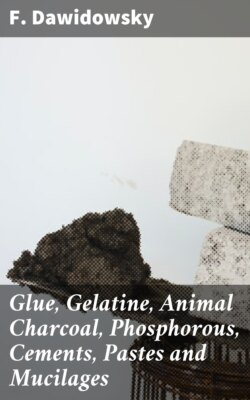Читать книгу Glue, Gelatine, Animal Charcoal, Phosphorous, Cements, Pastes and Mucilages - F. Dawidowsky - Страница 7
На сайте Литреса книга снята с продажи.
3. CONSTITUTION OF GLUE.
ОглавлениеIndependent of impurities and accidental constituents, glue consists of two distinctly distinguishable combinations, namely, glutin or gelatin and chondrin, the former being formed from the hide and osseous parts, and the latter from young bones while still in a soft state, and the “permanent” cartilages, such as those of the ribs and joints.
The manufacturer has it, of course, in his power to allow either of these substances to predominate in his product, but since experiments have shown glutin or gelatin to possess much greater adhesive power than chondrin, it is advisable to separate as much as possible the cartilaginous matter from other glue-yielding material.
As an accurate knowledge of these constituents of glue is of great importance to the manufacturer, brief reference will here be made to what scientific research has made known to us in regard to them.
Pure glutin or gelatin is obtained by treating buckshorn, etc., with water containing hydrochloric acid, until the phosphate of lime which serves, so to say, as a frame for the glue-yielding substance, is dissolved, and the organic tissue called collagen or ossein, remains behind. After freeing the latter from fat by steeping in milk of lime and careful washing, it is boiled, and the resulting jelly, when cold, mechanically distributed in cold water, in which it softens but does not dissolve. By thoroughly stirring the mass the glutin yields its coloring matter to the water, the latter being replaced by fresh water until all the coloring matter is extracted. Then pour off the water and after dissolving the jelly in hot water, filter the solution through a cloth. By mixing the filtered solution with an equal volume of alcohol, a precipitate of pure glutin is obtained. By the precipitation with alcohol, the separating glutin carries down inorganic salts, especially phosphates, which may be present in the solution. To free it from them, dissolve it in a small quantity of lukewarm water, acidulate the solution with hydrochloric acid and bring it into a dialyser. The salts and the acids diffuse in the water which has from time to time to be renewed, and finally a jelly of pure glutin remains behind; this is evaporated to dryness in shallow vessels.
Pure glutin, in a dry state forms a glassy substance, almost colorless, transparent to translucent, brittle or slightly elastic, free from odor and taste, and remains unchanged in the air. Its specific gravity is greater than that of water. It is neutral, exerts no influence whatever upon vegetable colors and is insoluble in alcohol, ether, hydrocarbons or oils. In cold water it swells up, absorbing as much as 40 per cent., and becomes opaque, but does not dissolve. It dissolves in hot water and on cooling forms a jelly even if the solution contains only 1 per cent. of glutin. It gelatinizes at a lower temperature than chondrin.
An aqueous solution of glutin is precipitated by chlorine, platinic chloride, tannin and alcohol, but not by hydrochloric acid, acetic acid, lead acetate, alum and ferric sulphate. Concentrated sulphuric acid decomposes glutin, forming, besides other products of decomposition, chiefly glycocoll and leucine.
When heated, glutin softens, swells and diffuses an odor of burnt hartshorn. In the air, it takes fire with difficulty, smokes, flames only for a few minutes, and leaves a bulky charcoal difficult to incinerate, the ashes of which consist principally of calcium phosphate.
Glutin, when in the jellied state, and treated with alcohol, undergoes dehydration, under the influence of which it contracts greatly. It was by this means that Gonnor succeeded in reducing in a remarkable degree the size of a print obtained in a very hydrated film of glutin, and transferring it, so reduced, to stone, from which he obtained a new impression, quite similar to the first, but more or less diminished.
By taking these prints, on the contrary, with glutin very little hydrated, and afterwards steeping them in water, a dilatation of the plate is obtained, which enlarges the figures with the same regularity.
Pure chondrin is prepared by boiling for from 24 to 48 hours the cartilages of the ribs, of the larynx with the exception of those of the epiglot, or of the windpipe and the bronchi.
Chondrin is precipitated from its solution by alcohol. The precipitate is redissolved in warm water, evaporated, and dried. It forms a semi-translucent mass of a slightly yellow color and resembles glutin as regards fracture and all external properties, but differs from it in being precipitated from its aqueous solution by mineral acids, acetate of lead, alum and ferric sulphate, and also by organic acids such as vinegar, citric and oxalic acids, none of which precipitate glutin.
As regards its chemical composition, chondrin is poorer in nitrogen than glutin, and contains more sulphur. Its formula approaches more closely that of albumen, which corresponds also with the origin of chondrin, for cartilages may be considered as transition-links between the proteïne and glue-yielding substances.
By the action of concentrated sulphuric acid upon chondrin, leucine is only produced but no glycocoll. By potassium hydrate chondrin is converted into glutin and yields then, like the latter, leucine and glycocoll. By boiling with concentrated hydrochloric acid chondrin is decomposed; a peculiar variety of fermentable sugar, to which the term chondroglucose has been applied, being formed.
It may finally be remarked that chondrin possesses less adhesive power than glutin and its presence in glue may be considered detrimental. To avoid its formation, the glue manufacturer should separate as much as possible cartilages from bones. Chondrin, however, is useful for size.
